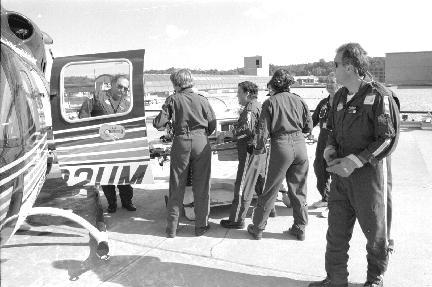The University Record, August 13, 1997
|
|
The flight team and hospital staff work together to ensure the safe delivery of the patient to the hospital facility. Photo by Bob Kalmbach |
Survival Flight, the Medical Center’s airborne medical transport program, is now one of only two services in the United States to be fully accredited in three categories.
The Commission on Accreditation of Medical Transport Systems (CAMTS) granted Survival flight three-year accreditation for its rotorwing, fixed wing and ground transport service-the highest recognition awarded. Of the more than 250 programs nationwide, only one other received accreditation in all three categories (MEDCENTER AIR in Charlotte, N. C.).
Survival Flight provides critical care transport, using the most up-to-date aviation and medical technology available 24 hours a day, 365 days a year. Specialty services include:
Transport of seriously ill and injured patients from other hospitals for specialized treatment at Medical Center.
Fast and safe evacuation of critically injured patients from accident scenes to trauma treatment facilities.
Transport of organs and organ transplant teams.
Support of police agencies during aerial searches, disaster management and triage.
Survival Flight operates with two twin-engine Bell 230 helicopters with an average speed of 172 miles per hour and a 200-mile radius. A cabin-pressurized Cessna Citation, Survival Flight LD is jet capable of flying 400 miles per hour with a coverage area over most of North America.
|
|
At left, helicopter pilot Tom Handzlik prepares for a flight while flight nurse Ben Tung looks on. All staff in the helicopter are required to wear safety equipment appropriate for conditions. In this case, Handzlik straps on a life vest, required for a flight over large bodies of water. Photos by Bob Kalmbach |



